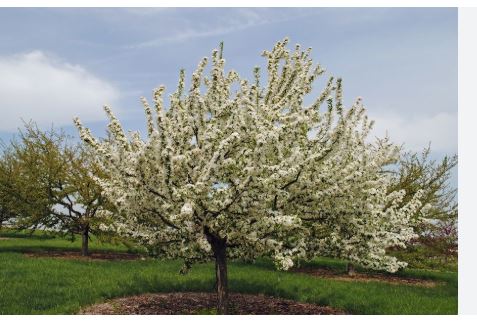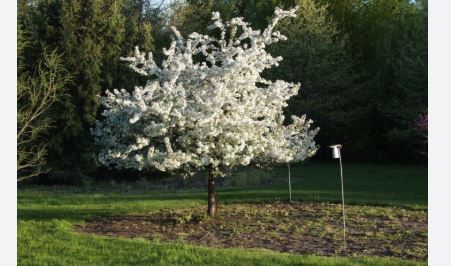
The Sugar Tyme Crabapple (Malus ‘Sutyzam’) is a breathtaking, disease-resistant ornamental tree renowned for its vibrant spring blossoms, persistent red fruit, and year-round landscape appeal. As a standout cultivar in the Malus genus, this deciduous tree is a favorite among gardeners, landscapers, and homeowners for its compact size, adaptability, and low-maintenance care.
Botanical Classification
The Sugar Tyme Crabapple belongs to the following taxonomic classification:
- Kingdom: Plantae
- Phylum: Tracheophyta
- Class: Magnoliopsida
- Order: Rosales
- Family: Rosaceae
- Genus: Malus
- Cultivar: ‘Sutyzam’ (Sugar Tyme)
The Malus genus includes both apples and crabapples, with crabapples typically defined by their smaller fruit (less than 2 inches in diameter). The Sugar Tyme Crabapple, patented as ‘Sutyzam’ (PP7062, COPF), is a hybrid cultivar specifically bred for its ornamental qualities, disease resistance, and persistent fruit, making it a standout in the Rosaceae family.
History of the Sugar Tyme Crabapple

The Sugar Tyme Crabapple was introduced by Lake County Nursery in Illinois as part of a series of ‘ZAM’ cultivars, with its official release in the late 20th century. It quickly gained recognition for its exceptional ornamental features and disease resistance, earning the 1999 Michigan Growers’ Choice Award and praise from noted horticulturist Michael Dirr as a top selection for home gardens.
The cultivar was developed through selective breeding to combine the best traits of its Malus ancestors, focusing on vibrant blooms, persistent fruit, and resistance to common crabapple diseases like apple scab, fire blight, cedar-apple rust, and powdery mildew.
Crabapples, in general, trace their origins to the mountainous regions of Central Asia, particularly Kazakhstan, where the wild apple species Malus sieversii is native. This ancestor spread across Europe and Asia via trade routes like the Silk Road and was introduced to North America by European colonists in the 17th century.
Native North American crabapple species, such as Malus coronaria (sweet crabapple) and Malus fusca (Pacific crabapple), also contributed to the genetic diversity of cultivated crabapples. The Sugar Tyme Crabapple represents a modern advancement, blending aesthetic appeal with practical traits for contemporary landscapes.
Native Area
As a cultivated hybrid, the Sugar Tyme Crabapple does not have a true native range but is derived from Malus species native to temperate regions of the Northern Hemisphere, including North America, Europe, and Asia. Its ancestral roots lie in Central Asia, particularly Kazakhstan, where wild Malus species thrive in mountainous regions.
Native North American crabapple species, such as Malus coronaria (eastern U.S.) and Malus fusca (Pacific Northwest and Alaska), may have contributed to its genetic lineage. Developed in the United States, the Sugar Tyme Crabapple is widely adaptable and thrives in a variety of climates, particularly across North America.
Identifying Characteristics
The Sugar Tyme Crabapple is celebrated for its compact form, vibrant seasonal displays, and year-round interest.
- Size and Shape: This small to medium-sized deciduous tree grows to a height of 14–20 feet with a spread of 10–15 feet, forming an upright, oval, or spreading canopy. Its compact, symmetrical form makes it ideal for small gardens, urban landscapes, or street plantings.
- Foliage: The leaves are ovate, slender, and sharply serrated, measuring up to 3 inches long. They emerge bright green in spring, turn glossy, rich green in summer, and transform into a golden-yellow or bronze-yellow in fall, creating a striking contrast with the red fruit.
- Flowers: In mid-spring (April–May), the tree produces masses of fragrant, pure white flowers that open from pale pink or shell-pink buds. These single-petaled blooms, arranged in clusters along the branches, feature bright yellow stamens and attract pollinators like bees and butterflies. The profuse bloom creates a snow-like effect, making it a standout in spring landscapes.
- Fruit: Following the blooms, the tree produces abundant radiant red pomes, approximately 0.5 inches in diameter, that persist from early fall through late winter unless eaten by birds. These glossy, cherry-sized fruits add vibrant color and contrast beautifully with the fall foliage and winter silhouette.
- Bark: The bark is greyish-brown, smooth and shiny when young, becoming slightly scaly or cracked with age. It adds subtle texture to the tree’s winter appearance.
- Growth Habit: The tree’s upright, oval habit becomes more open with age, maintaining a tidy, balanced form that requires minimal pruning. Its dense branching supports heavy flower and fruit production, enhancing its ornamental appeal.
Uses of the Sugar Tyme Crabapple
The Sugar Tyme Crabapple is primarily an ornamental tree, valued for its aesthetic contributions and practical benefits. Its uses include:
- Landscaping: The tree’s compact size, vibrant blooms, and persistent fruit make it ideal for specimen planting, accent trees, avenues, street trees, or backdrops in large beds. Its upright, oval form suits small parks, cottage gardens, city landscapes, or residential yards. It can be planted in groups or mixed with other cultivars for visual impact.
- Wildlife Support: The fragrant flowers attract pollinators like bees and butterflies, while the persistent red fruits provide a vital food source for songbirds and migrating birds, such as robins and cedar waxwings, from fall through late winter. The tree also serves as a host plant for butterflies and moths.
- Culinary Uses: While the tart, small fruits are not typically eaten raw, they can be used to make jellies, preserves, or cider due to their high pectin content. However, their primary value is ornamental, as they persist on the tree for visual appeal.
- Pollination: The Sugar Tyme Crabapple is self-pollinating and produces a heavy fruit crop without a pollinator. It also serves as an excellent pollinator for eating apple trees, enhancing fruit production in nearby orchards.
- Urban and Commercial Use: Its tolerance for urban conditions, including pollution, compacted soils, and drought, makes it a popular choice for city parks, commercial properties, or parking lot islands. Its disease resistance reduces maintenance needs in public spaces.
- Espalier and Formal Designs: The tree’s tidy form and attractive branching make it suitable for espalier training or formal hedging when planted 10–15 feet apart. It can also be used in bonsai for unique garden features.
Growth Rate
The Sugar Tyme Crabapple has a relatively fast growth rate compared to other crabapple cultivars, adding 12–24 inches per year. It reaches flowering and fruiting maturity within 3–5 years and achieves its mature height of 14–20 feet in approximately 8–12 years. However, like many crabapples, it is relatively short-lived, with a lifespan of 20–30 years under optimal conditions. Its vigorous growth ensures quick establishment, making it a popular choice for gardeners seeking rapid visual impact.
USDA Hardiness Zones
The Sugar Tyme Crabapple thrives in USDA Hardiness Zones 4–8, making it suitable for a wide range of climates, from cold northern regions to warmer southern areas. It performs best in full sun (6+ hours daily) to maximize flowering and fruit production, though it tolerates partial shade with reduced blooms and fruit.
The tree prefers well-drained, slightly acidic soils (pH 5.5–6.8) but adapts to various soil types, including loam, clay, or sandy soils. Once established, it is drought-tolerant and moderately tolerant of urban pollution, though it may struggle in regions with high humidity and temperatures consistently above 45°F, which can increase disease risk.
Fun Fact
The Sugar Tyme Crabapple is listed as one of Fleming’s Top Ten Flowering Trees and is a “proven performer” on the Wisconsin Horticulture Extension Office’s list of disease-resistant crabapples. Its name, ‘Sutyzam,’ is derived from its introduction by Lake County Nursery’s ‘ZAM’ series, and its exceptional disease resistance and year-round beauty have made it a favorite among landscape architects and universities.
Care and Maintenance Tips
To ensure the Sugar Tyme Crabapple thrives, follow these care tips:
- Planting: Choose a site with full sun and well-drained soil. Dig a hole twice as wide and as deep as the root ball, spreading roots carefully. Apply a 3–4-inch layer of organic mulch (e.g., bark chips) around the base, keeping it away from the trunk to prevent rot. Plant in spring or fall for best results.
- Watering: Water regularly during the first year to establish roots, providing about 1 inch of water per week. Once established, water only during prolonged dry spells or extreme heat, as the tree is drought-tolerant.
- Pruning: Prune in late winter or early summer (May–June) after blooming to remove dead, diseased, or crossing branches and to maintain shape. Avoid spring pruning to prevent fire blight infection. Minimal pruning is needed due to the tree’s tidy form.
- Fertilization: Apply a balanced fertilizer or compost in early spring if soil is poor or growth is slow. Avoid over-fertilizing, as excess nitrogen can increase disease susceptibility. In decent soils, the tree often thrives without additional fertilization.
- Pest and Disease Control: The Sugar Tyme Crabapple has excellent resistance to apple scab, good resistance to fire blight, cedar-apple rust, and powdery mildew, reducing the need for chemical treatments. Monitor for minor pests like aphids, apple sawfly, or spider mites, which rarely cause significant damage.
- Site Selection: Plant at least 10–20 feet from buildings or other trees to accommodate its mature spread and ensure good air circulation, which minimizes disease risk.
Challenges and Considerations
While the Sugar Tyme Crabapple is low-maintenance, there are a few considerations:
- Fruit Drop: The persistent red fruits may fall in high-traffic areas, requiring occasional cleanup. However, their small size minimizes mess compared to larger crabapples.
- Disease Susceptibility: Although highly disease-resistant, the tree may be susceptible to fungal diseases like fire blight or apple scab in hot, humid climates with poor air circulation. Regular monitoring and proper pruning help mitigate risks.
- Seed Toxicity: Like all Malus species, the seeds of the Sugar Tyme Crabapple contain small amounts of amygdalin, which can break down into toxic cyanide if crushed and ingested. However, the risk is minimal, as the sour fruits are not typically consumed, and whole seeds pass through the digestive system harmlessly.
- Lifespan: The tree’s relatively short lifespan (20–30 years) may be a consideration for long-term landscape planning.